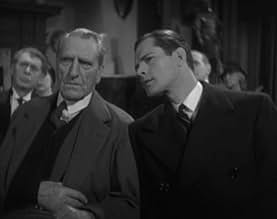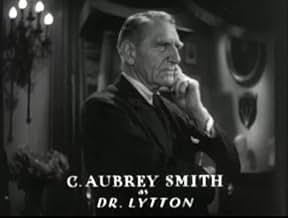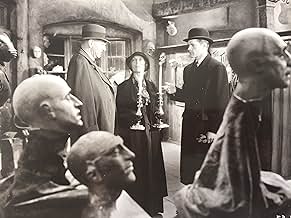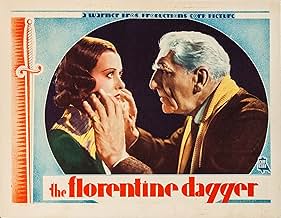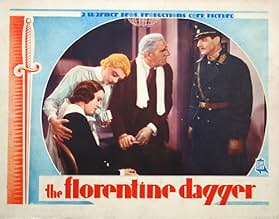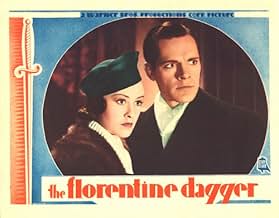Adicionar um enredo no seu idiomaJuan Cesare, a descendant of the Borgias of Vienna, thinks he may have a murder streak in him acquired from his long-dead relatives, is is love with Florence Ballau, but her father lodges a ... Ler tudoJuan Cesare, a descendant of the Borgias of Vienna, thinks he may have a murder streak in him acquired from his long-dead relatives, is is love with Florence Ballau, but her father lodges a strong protest. Victor Ballau is later found dead with a Florentine dagger of the Borgia t... Ler tudoJuan Cesare, a descendant of the Borgias of Vienna, thinks he may have a murder streak in him acquired from his long-dead relatives, is is love with Florence Ballau, but her father lodges a strong protest. Victor Ballau is later found dead with a Florentine dagger of the Borgia type stuck firmly in him. Juan is all wrought up and tortured by thoughts he may have been ... Ler tudo
- Direção
- Roteiristas
- Artistas
- Bartender
- (cenas deletadas)
- Newspaper Editor
- (cenas deletadas)
- Eric - Night Watchman
- (não creditado)
- Detective
- (não creditado)
- Direção
- Roteiristas
- Elenco e equipe completos
- Produção, bilheteria e muito mais no IMDbPro
Avaliações em destaque
"If there's one thing more useless than a talkative woman it is one that is determined not to talk."
Woods and Lindsay fall in love, but O'Neill is stabbed to death with one of the three Florentine daggers we had seen displayed earlier. Woods becomes the main suspect because of his erratic behavior and he is, after all, a Borgia. But Lindsay seems a tad off also. And Smith is always lurking. Enter the local inspector (Robert Barrat), a happy fellow who seems totally uninvolved with the murder case and is always receiving phone calls from Julia. Lindsay had left the play in a rush and is jailed on suspicion of murder. But then there is another dagger attackthis time on Smith. That clears Lindsay. Or does it? The police had let her go. Woods and Smith end up at an auction house, following a wigmaker (Eily Malyon) who buys the candle sticks that were found by O'Neill's body. Everyone converges at the wigmaker's shop and the crime is solved. All very tidy and clever. Barrat threatens to steal the film from the more stolid actors, but his character is too unbelievable, especially as he lets the murderer go free! Go figure.
Paul Porcasi is a police man, Henry Kolker is the auctioneer, Florence Fair is the weird maid, Herman Bing (who has no part) is the baker, Louise Seidel is his assistant, and Frank Reicher is the stage manager. Woods is boring, Lindsay is miscast, and Smith is relatively subdued. Only Barrat and Malyon seem to have much life. Judels serves as the castle your host, but Ottiano seems irrelevant to the story. Makes one wonder about the editing here as Ottiano and Bing have no reasons to be in the story. And the play is a STINKER!
Very atmospheric for such a small film with some good performances, particularly by Robert Barrat as a police inspector who's quite funny. Lindsay is miscast as this mysterious, goddess-like woman whose performance is the talk of Vienna. A Greta Garbo role in the hands of Margaret Lindsay, a completely different type.
A short film, fairly well done given the budget.
When O'Neill becomes the victim of a stabbing, the plot thickens as Detective Von Brinkner (ROBERT BARRAT) goes about trying to solve the crime. But it's really C. AUBREY SMITH who does most of the snooping to uncover the reason behind O'Neill's vicious death.
However, it's Barrat's lively performance as the playboy detective that gives a lift to the story and a bit of humor that's badly needed.
It's really a B-film struggling to look like an A-film with some proper atmosphere and period settings, but the story is told in dull fashion and never quite becomes as fascinating as the film's imaginative title.
Oddball little movie, not quite a whodunit since the suspects are too under-developed to pick through. The result is more like an early noir with Cesare (Woods) struggling against dark forces and maybe fate, too. In fact, I'll bet the lighting bill didn't exceed 5 bucks. Also, I'm with the reviewer pointing out that Woods lacks the expressive depth to play the central character effectively. Too bad, because that would have made the movie more memorable. On the other hand, there's the craggy-faced Aubrey Smith as a commanding head doctor, and a most un- cop-like Robert Barrat as chief cop. And what about actress Eily Malyon whose close-ups are enough to scare off both Karloff and Lugosi.
All in all, I'm not sure the movie knows where it wants to go. The threads do not blend well. Still, there are some creepy moments that manage to compensate. Then too there's that surprise ending where justice happily triumphs over law. Looks like the screenplay (1935) managed to sneak this by a newly installed Production Code (1934). Anyway, my guess is that when Barrat leaves the airport he's headed to the Playboy Club no matter what he's told the wife.
Você sabia?
- CuriosidadesWarner Bros. created the advertising marketing ploy "Clue Club" to increase audiences attending its crime mystery/drama movies. Twelve titles showing the Warner Bros. "Clue Club" promo footage were released from 1935 to 1938.
Clue Club #1: The White Cockatoo (1935)
Clue Club #2: While the Patient Slept (1935)
Clue Club #3: The Florentine Dagger (1935)
Clue Club #4: The Case of the Curious Bride (1935)
Clue Club #5: The Case of the Lucky Legs (1935)
Clue Club #6: The Murder of Dr. Harrigan (1936)
Clue Club #7: Murder by an Aristocrat (1936)
Clue Club #8: The Case of the Velvet Claws (1936)
Clue Club #9: The Case of the Black Cat (1936)
Clue Club #10: The Case of the Stuttering Bishop (1937)
Clue Club #11: The Patient in Room 18 (1938)
Clue Club #12: Mystery House (1938)
Principais escolhas
Detalhes
- Data de lançamento
- País de origem
- Idiomas
- Também conhecido como
- The Florentine Dagger
- Locações de filme
- Empresa de produção
- Consulte mais créditos da empresa na IMDbPro
- Tempo de duração1 hora 9 minutos
- Cor
- Mixagem de som
- Proporção
- 1.37 : 1
Contribua para esta página


